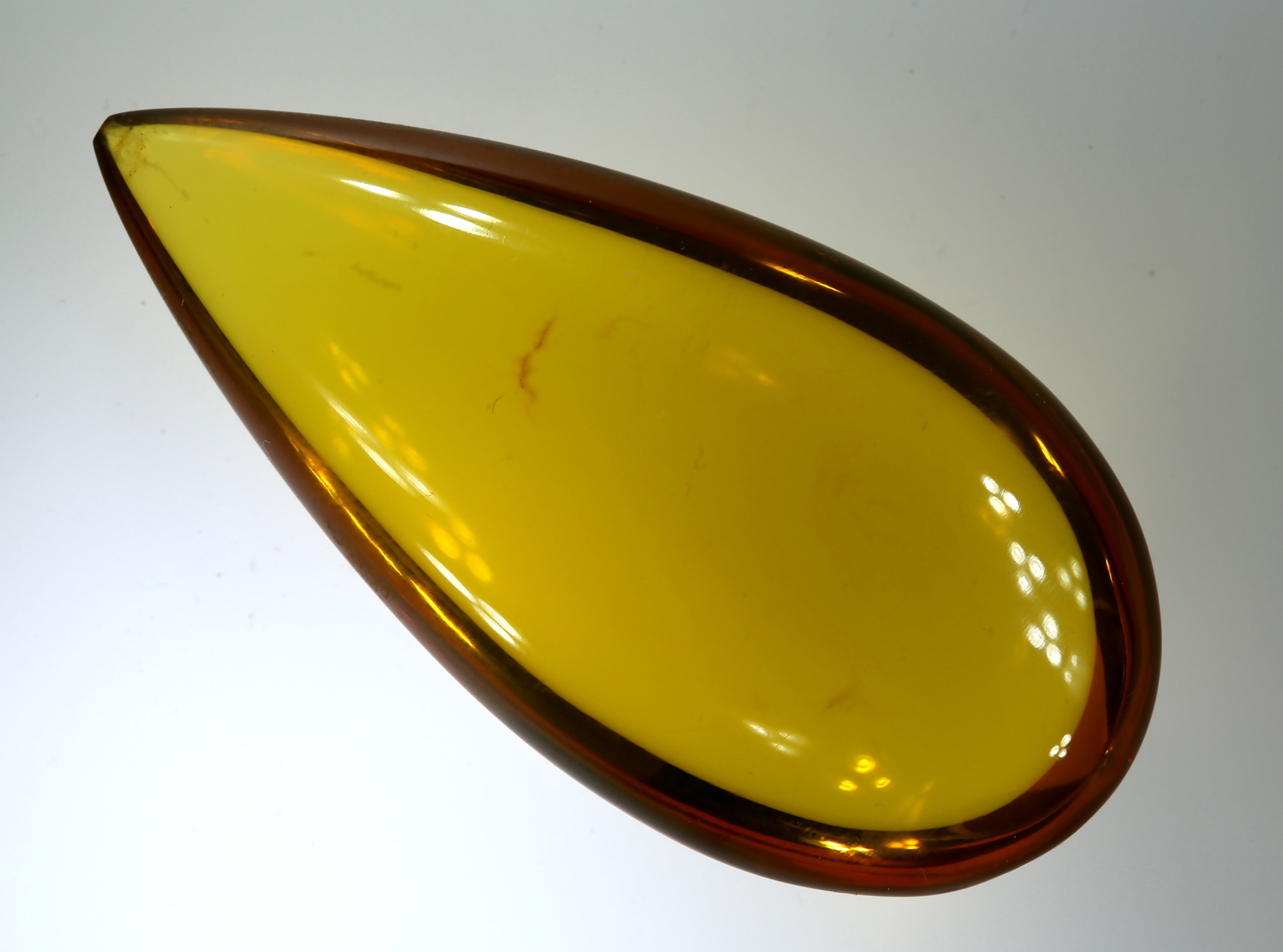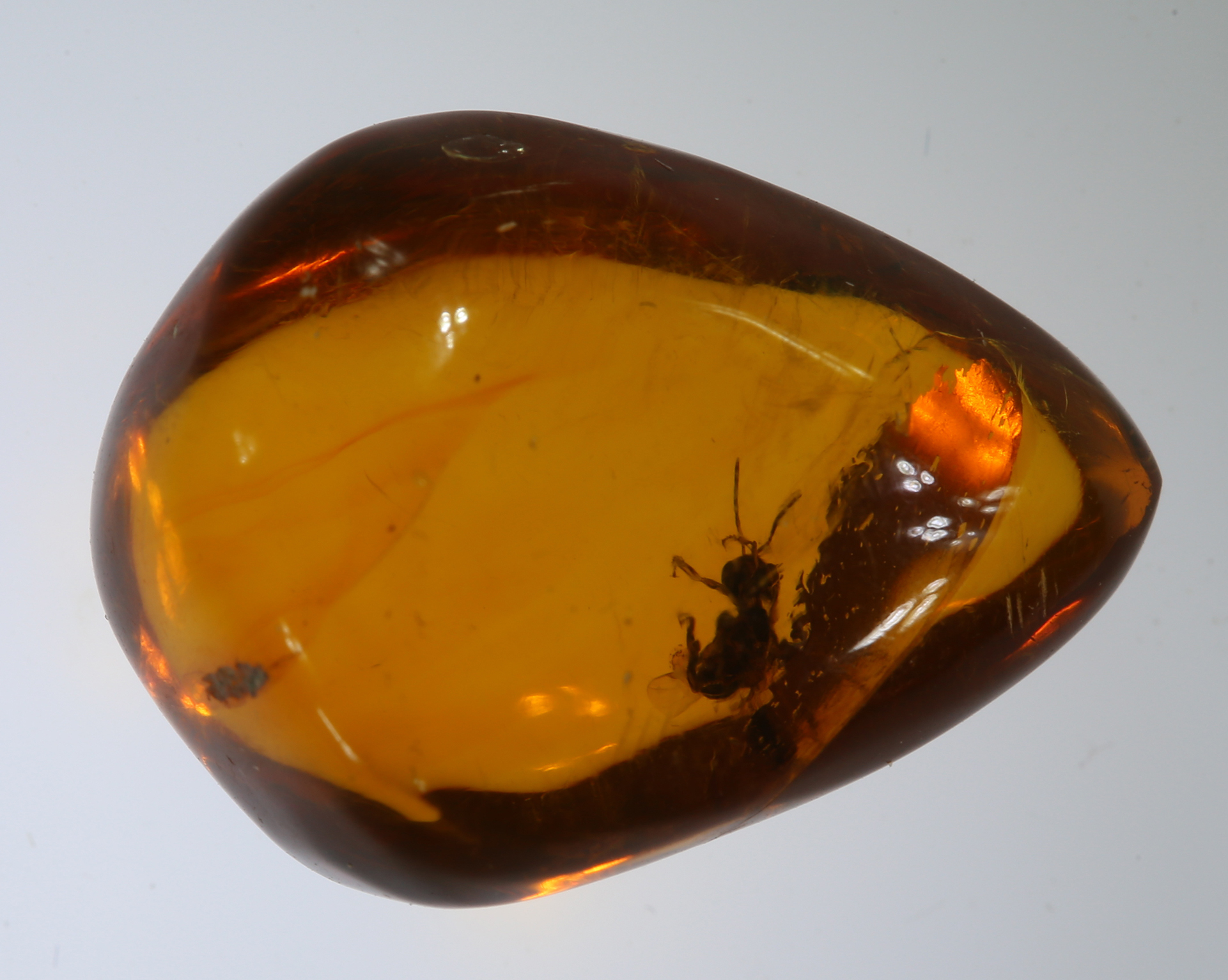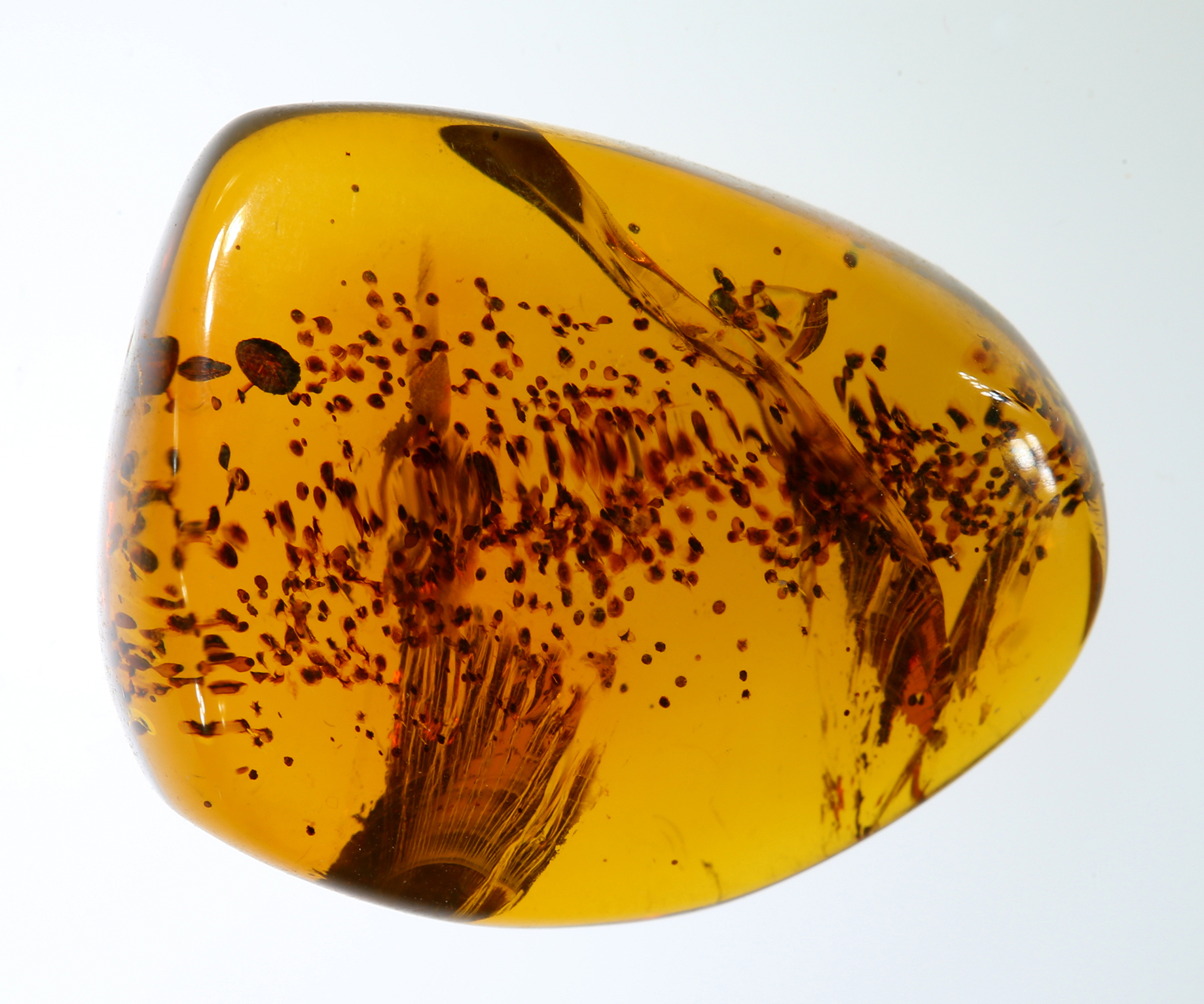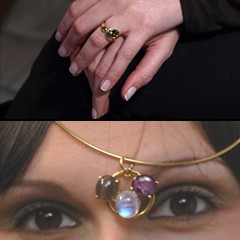
This diptera with its beautiful wings interrupted its brief flight in space for a longer flight, over the time, of millions of years, to reach our emotions and our awareness.

Freeze a blow of wind that scatters a hundredth of a milligram of pollen in the air. This was a creative twist of some God in mood for poetry.
Fruit trees, conifers, leguminous crops, secrete a resin that with heat tends to turn almost liquid, and drips down from the trunk, and entangles tiny insects, pollen, flowers and other things it encounters on its way. After which, the volatile substances within its complex chemical formula vanish, and the resin becomes more compact, almost a crystalline paste. Years pass; millions, tens of millions of years, and the resin is polymerized, fossilized, whilst inside it, the pollen, eggs, flowers, insects and tiny vertebrates have remained unaltered. The age of amber ranges from ten to a hundred million years; human history dates back to about one hundred and fifty thousand years, so a piece of amber is from two hundred to five hundred times older than Adam and Eva, although ants enclosed in it are similar to those that populate our gardens. Time sometimes moves in disconcerting ways; insects trapped in amber scream their tragedy twenty times older than that of Jesus.
Amber is the youngest among the precious stones. In the history of the world thirty million years are nothing; some stones are billions of years old. Amber is one of the most hold and light stones; a robust fingernail can scratch, and almost floats in salt water. Amber is a precious stone although it is not a stone, because it comes from the plant kingdom (and sometimes inside there are representatives of the animal kingdom). Amber is also an Italian precious stone. In Sicily it was discovered the best quality existing, The “Simetite”, in the bed of the river Simeto. Since they regulated with dams and levees the river, there is almost no more, and you have to be satisfied of the material coming from Baltic sea, Dominican Republic or Mexico. Amber has many mythical origins, legends, therapeutic properties, magical powers. Amber is the first gemstone mentioned by Plinio the Elder (23-79 AD) in his splendid “Naturalis Historia” (Book XXXVII, which I highly recommend reading).
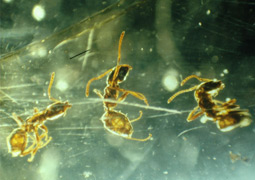
The ants we are used to see walk in single row. And in single row these three ants have been walking for millions of years, towards an unknown anthill.
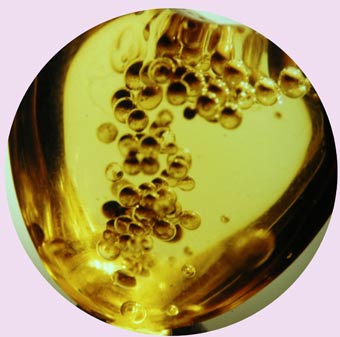
The bubbles of air or gas move upwards, but these are not bubbles: they are eggs of an insect. Generally, they move into the horizontal space, spreading life on the planet. Here they have moved in the vertical, perforating the time axis.
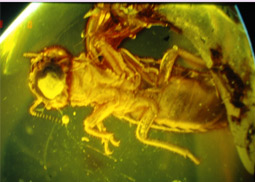
It looks like a cricket; an entomologist may give scholars an outline, but the dramatic expressiveness of the posture of death of this insect needs no explanation. Insects do not express feelings. This may be true, but the dignity and the poise of this insects’ death pose which looks like a cricket, proves the opposite.
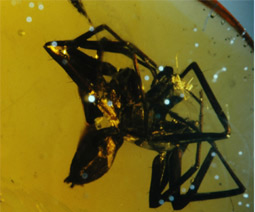
A spider grabs a tiny prey. The liquid resin entangles it but, so as not to give a chance to the captured insect, it lets itself be wrapped and its eyes look as if they could eye you suspiciously during the night!
Let Plinio the Elder do the talking; probably we’ll be amazed at his modernity, his freshness, his know-how about the “quality” of things.
34- Demostrato calls it “Lyncurium” and says it derives from the urine of the lynx, from the males that of red and firey color, from the females that of a softer and purer color. 38… According to Teomene near the big Sirte there is the Garden of the Hesperides and the pond of Elettro; here there are poplar trees from whose tops amber falls into the pond, to be collected by the Hesperides maidens. 39 Ctesias declares that in India there is the ‘Ipobaro’ river, its name means that ‘which brings all things good’; it would flow from North to the eastern part of the Ocean at the feet of a wooded mountain of trees that produce amber, such trees would be called ‘Psittacore’, nome that would mean ‘nectarous gracefullness’. 46… That at the start amber drips liquid is demonstrated by the fact that some scoria, scuh as ants, mosquitoes and lizards shine through inside; no doubt they have remained limed to the fresh substance and hence have been pent-up with its hardening. 47 There are numerous varieties of amber. Within these, the white has an extraordinary fragrance, but neither these or those that have a waxy color are of value; the yellow-reddish ones are considered of better quality and within these better valued are the see-through ones, except if for too much vividness of fire they seem flaming: the fact that their color reminds of fire is very much appreciated, but they should not ‘be fire’. The most acknowledged are the so-called Falerne, their color is that of wine, of a transparent and smooth color; within these also the diaphaneity of cooked honey is very much treasuerd. 48 On this wise, it is better that these following notion be known: amber can be dyed by whichever manner one wants to, with goat tallow, with the root of wild starflower, since nowadays they can even be dyed with purple. Furthernore, rub your fingers, having received the vital spark from their color, they lure straws, dry leaves and barks of basswood, just like a magnet draws iron. Eventually, amber swarf, together with oil, burns with more light and lasts for a longer time than linen oakum. 49 The appraisal of amber within luxory goods is such that even a very small statue depicting a man far exceeds the price of alive vigorous men.
Since we are in the mood for ancient quotes (and amber is particularly suitable for this time travel), we take from Orazio (65-8 BC). Book IV, epigram LIX:
A viper climbed on weeping branches of Elladi, the liquid pearl of yellow amber meets her and drips on her. Stunned at being stopped by this sticky dew, it immediately loses its sense of movement and remains a prisoner in this icy matter. Do not boast, Cleopatra, of your royal tomb, as a viper rests in a coffin far more noble than yours.

Inclusions with insects in amber are rare, those with plant are very rare, and those with vegetables and insects, of course, even more rare. But we are still in the order of “quantity”. What about a petal of a flower (probably of “Imenea Protera”), on which two diptera are laid to copulate? Their delicate moment of love is a poem that went through the time barrier, and broke that of the emotions.
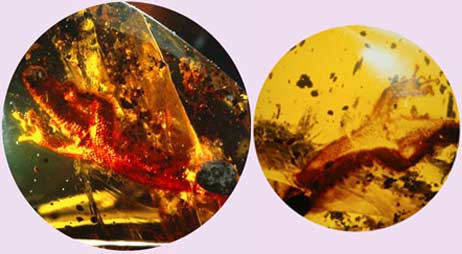
Lizard. The dream of any collector of inclusions is not to possess a lizard in amber, but at least to see one. I’m lucky, because I’ve also photographed (and these pictures were published in various magazines).
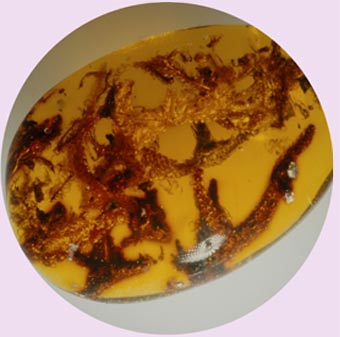
The beauty of certain inclusions in amber, is the mystery that accompanies them. In certain cases we must appeal to specialists only to know if these inclusions are of vegetable or animal origin. The good thing is that the pure charm of beauty does not need much explanation.

The vegetable Inclusions in amber are much rarer than animals ones. A leaf, a seed, pollen, once detached from the plant have completed their task and float onto the resin, while the insect is struggling but gets entangled. Even though these parts of the seed seem wings waiting to take off in flight.
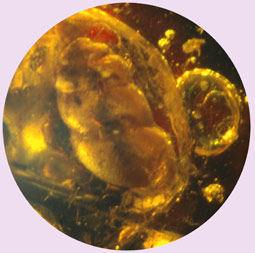
Amber is a resin dripping from the trees, the shells are found in the sea, away from the trees, but there are shells of land snails … one of these, almost two millimeters long, with its slow journey, traveled more than thirty millions of years to come, immaculate, and reach us.

When we speak of “Ikebana” we mean that magical moment when flower, nature, emotions, artist, atmosphere, participate in a single vibration of harmony and beauty. The “Ikebana” art is made to last a day, a moment, a throb. Mother Nature welcomed flower arrangements that will sing their own harmony forever.
Specifications
NAMES: AMBER – Elektron, Succinite, Retinite, Simetite, Rumenite, Burmite, Gedanite. Generally, names are related to the origin.
SIMILAR STONES: The “copal” It is a natural younger resin, which will become amber in a few million years’ time. It’s more tender and has a characteristic smell; It may have inclusions of animals that can be very impressive.
MAIN SOURCES: North Sea; Dominican Republic; Italy (Sicily); Romania; Burma; other deposits do not offer clear samples.
COLOR: The most valuable are of an intense yellow-orange color. More frequent are: yellow, brown, white-green, and so on. Specimens of value must still be transparent. Interesting are those with blue fluorescent shades.
HARDNESS: from 2.5 to 3.5.
SPECIFIC WEIGHT: 1.03 to 1.13; generally about 1.04.
INDEX OF REFRACTION: 1.54 – amorphous monorifrangent with anomalous birefringence.
FLUORESCENCE: from UV-transparent, opaque to white-ish.
MICROSCOPE: It’s the most exciting stone to be examined under a microscope. In addition to the typical inclusions, one can meet organic remains such as pollen, eggs, flowers, insects, tiny vertebrates.
CHEMICAL FORMULA BASE: (C10H16O).(H2S) Given that it is a mixture of hydrocarbons with various acids, the formula is very variable.
CUT: Cabochon with no regular form; the cut is to highlight the area of deepest color, or some particular inclusion. To make necklaces, the material without inclusions is particularly exciting to work with, and one can drill spheres, or make other forms.
WARNING: This stone is very tender, to be handled with great care and do not put on flame. It melts at 300 Celius degrees. Any spoliture are removed by rubbing with cesium oxide, lipstick for goldsmiths. It cleans with suede and dilute alcohol.
NOTE: The best amber is Sicilian, but they are rare. Until deposits were discovered in Santo Domingo and Mexico, Baltic amber was among the most sought for.
IMITATIONS: a trained eye distinguishes plastic from natural amber at a glance. More insidious is the reconstituted amber or pressed (ambroid), which is made with natural resins and synthetic resins fused together.
NOTE: The grey amber, used in cosmetics, has nothing to do with amber; it is the intestinal secretions of the cachalot.





